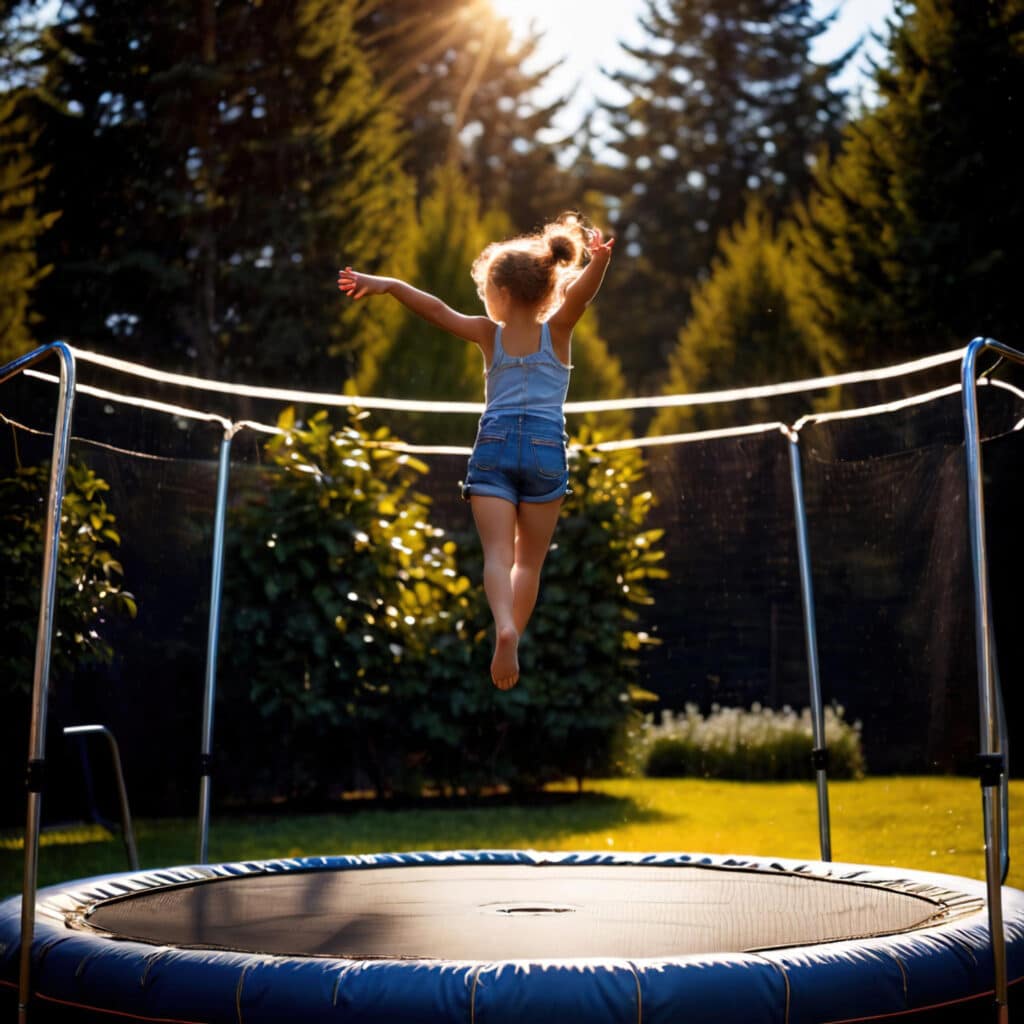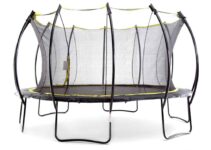For making a Trampoline bounce better, you can clean debris, wet the jumping mat, lubricate the springs and other parts, inspect whether the trampoline loses its elasticity or not, and if they are not working then you can replace the rusted or damaged spring, mat, and other components.
Overall, there are several factors to make your Trampoline bouncy. They related to the trampoline shape, size, Spring Constant of Trampoline spring, number of springs used, wear and tear on springs, and many more.
In this article, I will bring the bigger picture on every aspect that makes the bounce and guide you with every possible answer.
Let’s explore!
What Factors make the Trampoline Bouncy?
Trampolines bounce due to the system of springs attached to the fabric, which follow Hooke’s Law and exert a pushback force based on the applied force.
Hooke’s Law states that the force exerted on a spring is proportional to its extension or compression, which determines the bounce height on a trampoline.
Hooke’s theory only works on elastic bodies such as trampolines, rubber products, and latex.
There are some additional factors that make your Trampoline more bouncier:
Elasticity: The elasticity of the trampoline mat and springs determines how efficiently they can store and release energy, affecting the height of the bounce.
Jump force: The harder you jump on a trampoline, the higher you will bounce due to the springs reacting to the applied force.
The force exerted by the jumper onto the trampoline mat impacts the compression of the springs and the energy stored, thus affecting the height of the bounce.
User’s body weight: Heavier individuals may exert more force on the trampoline, leading to a deeper compression of the springs and potentially resulting in a higher bounce.
Trampoline shape and size: The design and dimensions of the trampoline can also influence the bounce height, with larger trampolines typically providing higher bounces due to their increased surface area and more springs.
Additionally, trampolines with a rectangular shape often offer a more consistent and powerful bounce compared to round trampolines.
How to make a Trampoline Bouncier?

Firstly, it’s important to understand the basic mechanics of a trampoline. Traditional trampolines consist of a mat connected to a frame by a series of springs. When weight is applied to the mat (by jumping), the springs stretch and store potential energy. When the weight is released, this potential energy is converted into kinetic energy, propelling the jumper upwards.
To get your trampoline bouncier follow these steps:
1. Choosing the right type of Trampoline that bounces better:
Choose a square trampoline over a round one as a bouncier trampoline.
Springfree jumbo square trampoline ensures more bounce almost 20% more than any round trampoline. So, here get to know choosing the right trampoline is also a factor when you want the maximum bouncing height.
On the other hand, a Round trampoline is used for the double bounce. So, if you opt for a flip out of double bounce then choose a circle or round Trampoline.
2. Learn the Jumping Physics:
It’s you that make the Trampoline bouncy, do you know that?
But before we get into how to do it, let’s understand why it works. The basic idea of a trampoline is all about its springs. These springs store energy when you squish them down and then let it out as you jump. Tinkering with these springs will make them just right for super bouncy jumps.
Figure out how high you can jump without a trampoline; that being said, the ability of a person to jump higher on a ground surface determines how much energy he/she can produce so that, the Trampoline can store it
3, Maximize Your Trampoline’s Bounce Without Crossing the Springs
Crossing springs can make the enclosure more rigid and therefore, you will get some extra bounce. However, it makes challenging to control movements.
Moreover, crossing your trampoline springs can lead to uneven weight distribution, premature wear and tear on the springs, compromised structural integrity, and safety risks.
According to aap.org, most of the trampoline injury in the park caused by crossing the springs to maximize bounce hight.
Now, let’s talk about the trick. Here’s how you can make your trampoline bouncier without crossing the springs:
Check Your Trampoline: First, give your trampoline a good once-over. Look at how long the springs are and check if they’re in good shape. See if the tension feels right.
In that case, Propel Trampolines have excellent bounce for the additional number of added springs and good quality jumping pad.
Tweak the Spring Tension: If your trampoline lets you do it, think about adjusting how tight the springs are. Most trampolines have settings where you can change this. Try different levels of tightness until you find the one that gives you the biggest bounce.
Get Better Springs: If your trampoline’s springs are old or not so great, think about getting new ones. Good-quality springs can really boost your bouncing power without needing to mess around with anything else.
Spread Out: Pay attention to how people are using the trampoline. Make sure everyone is spread out evenly and not all squished into one spot. This helps the springs and mat wear out more evenly, so you get a better bounce for longer.
4. Checking the Trampoline Mat
A mat that needs to take care of, so let’s show you some tips on it so that you will get a better bounce
Wetting Your Trampoline Mat:
A trampoline soaked with water. Sounds bizarre, right? But trust me, this unconventional trick works wonders. Wetting the trampoline mat will result in higher jumps and smoother landings. It’s a simple yet effective way to boost bounce performance, perfect for those seeking an extra edge in their bouncing adventures.
Fix the Wear and tear of your Trampoline Mat:
As time passes and your trampoline gets its fair share of use, the mat might start to stretch out or show signs of wear and tear. This wear can seriously impact the bounce, so keeping an eye on your mat’s condition is key. Here’s what you should do:
First off, give your trampoline mat a thorough inspection. Look closely for any stretching, sagging, or tears. If you notice any of these issues, it’s time to take action.
If the mat is just sagging a bit but is otherwise in decent shape, you might be able to tighten it up. You can adjust the tension of the springs or consider using additional attachments, like mat tensioning straps, to pull the mat taut again.
However, if the mat is significantly stretched out or has damage that can’t be fixed, it’s best to replace it entirely. Look for a high-quality replacement mat that’s specifically designed for your trampoline model to ensure a proper fit and optimal bounce.
5. Trampoline Springs’s Length differs in the bounce higher or lower:
The length of trampoline springs affects the bounce and user experience. The longer length of spring is safer but the shorter length of a trampoline spring is bouncier. Shorter springs provide a firmer and faster bounce, preferred by gymnasts and those wanting a dynamic surface. They enhance advanced tricks and offer controlled movement. Longer springs give a gentler and smoother bounce, favored by recreational users. They absorb impact better, reducing risks of injury and joint strain.
6. Use V-Shaped Connection for the Trampoline Spring:
The V-shaped connection for trampoline springs. This simple yet effective technique can make a world of difference in how your trampoline performs. Here’s how to do it:
Step 1: Start by removing the existing springs from your trampoline. This clears the way for the V-shaped connection.
Step 2: Now, instead of the usual straight line, opt for a V-shaped connection. Attach the springs to the frame in a V formation, with one end of each spring connected slightly further out than the other end.
Step 3: Once you’ve created the V shape connection, it’s time to fine-tune the tension of the springs. You want them snug enough to deliver a satisfying bounce but not overly tight to strain the trampoline frame.
Step 4: Test and tweak! Give your trampoline a bounce test to gauge the feel. Adjust the tension or positioning of the springs as needed until you achieve the perfect bounce.
7. Adding more Springs to make a Trampoline Bouncy
The number of additional springs required depends on various factors, including the size and weight capacity of your trampoline. A trampoline expert can assess your specific needs and recommend the appropriate number of springs for optimal performance.
Here’s what you need to know:
First, take a good look at how your trampoline is performing. If it’s not bouncing as high as you’d like, adding extra springs could be the answer.
Extra springs can boost the bounce, especially for larger trampolines or when multiple people are jumping. It’s like giving your trampoline a serious upgrade!
8. Lubricating Springs
Oftentimes, the springs of a trampoline become rusty. Hence lubricating the springs will give you the extra bounce again, this is a part of a Trampoline mantainence to lubricate it after every six months.
Alright, let’s walk through the process of lubricating your trampoline, no matter its shape.
At first, you will need an old carpet or something to catch drips, a towel, a dish with a toothbrush, gloves, and the right lubricating oil.
Secondly, Lay down your protective covering to keep your space clean. If your trampoline has a spring cover, gently remove it, exposing the springs. Carefully cover any areas you don’t want oil on with plastic wrap or similar protection.
Now, let’s get to the springs. With gloves on, hold a towel underneath to catch any drips. Using the toothbrush, apply the oil to the edges of the springs, making sure not to get any on the springs themselves.
Give them a good scrub to make sure the oil gets where it’s needed. If possible, rotate the springs for even coverage. Don’t forget to check any hinges or other moving parts for signs of wear and lubricate them too.
Now, test it out with some gentle bouncing to distribute the oil. If there are still squeaks or stiffness, apply more oil and repeat the process.
Once you’re satisfied, clean up any excess oil and dispose of your materials responsibly. Now you’re all set for some smooth bouncing fun!
Do heavier people bounce higher on a trampoline?

Bounce height on a trampoline depends on a few things, like how heavy the person is, how the trampoline is made, and how hard they jump. You might think that heavier folks bounce higher because they put more weight on the trampoline, but it’s not that simple. Let me break it down for you:
So, weight does matter, but it’s not the only thing that affects how high you’ll bounce.






